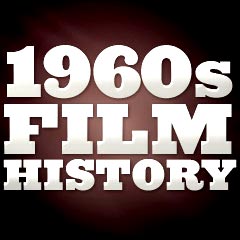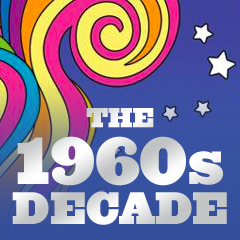|
New and Old Themes in 60s Westerns:
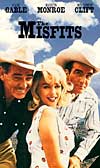 Although
westerns enjoyed a revival, many 1960s westerns were down-beat and heavy-handed,
portraying the themes of the fading West and the perilous plight of the
aging Westerner living off past glories. John Huston's anti-Western The
Misfits (1961), based on Arthur Miller's prophetic screenplay
about ex-cowboys in a modern world, starred Miller's wife Marilyn Monroe
as a Reno divorcee, and Clark Gable and Montgomery Clift as mustang-horse
wranglers. Poignantly, it was both Gable's and Monroe's last film - shortly
after filming wrapped, each of them died (in late 1960 and in mid-1962
respectively) - with Clift following shortly thereafter in 1966. Although
westerns enjoyed a revival, many 1960s westerns were down-beat and heavy-handed,
portraying the themes of the fading West and the perilous plight of the
aging Westerner living off past glories. John Huston's anti-Western The
Misfits (1961), based on Arthur Miller's prophetic screenplay
about ex-cowboys in a modern world, starred Miller's wife Marilyn Monroe
as a Reno divorcee, and Clark Gable and Montgomery Clift as mustang-horse
wranglers. Poignantly, it was both Gable's and Monroe's last film - shortly
after filming wrapped, each of them died (in late 1960 and in mid-1962
respectively) - with Clift following shortly thereafter in 1966.
Remarkably, the comedy western Cat Ballou (1965) with its title
song performed by Nat King Cole and Stubby Kaye, brought a Best Actor
Oscar to Lee Marvin (in a dual role as gun-fighting brothers), often seen
on a drunken horse.
Eastwood in The "Spaghetti" Westerns:
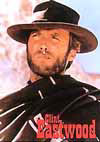 Clint Eastwood, who played Rowdy Yates on TV's Rawhide from 1959
to 1966, would go on to greater heights in his career after starring in
the first of three "The Man With No Name" entries and becoming
an iconic figure. The first film was an Italian/Spanish/German co-production
with European actors. Sergio Leone's entire "Dollars Trilogy"
reinvented the Western with his Italian-made "spaghetti westerns,"
including:
Clint Eastwood, who played Rowdy Yates on TV's Rawhide from 1959
to 1966, would go on to greater heights in his career after starring in
the first of three "The Man With No Name" entries and becoming
an iconic figure. The first film was an Italian/Spanish/German co-production
with European actors. Sergio Leone's entire "Dollars Trilogy"
reinvented the Western with his Italian-made "spaghetti westerns,"
including:
- A Fistful of Dollars (1964) - with a storyline
derived from Japanese director Akira Kurosawa's Yojimbo (1961);
originally titled El Magnifico Stragnero (The Magnificent
Stranger)
- For a Few Dollars More (1965)
- The Good, The Bad, and the Ugly (1966), notable
for its Ahh-eee-ahh-eee-ahhhhh...Waah...waah...waah theme music
by Ennio Morricone, and Eli Wallach as Tuco
Eastwood also began a decades-long collaboration with action-film director
Don Siegel with his appearance as an Arizona lawman in NYC in Coogan's
Bluff (1968).
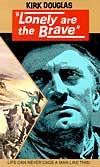 Lonely
Are the Brave (1962) - a Hollywood Western set in modern times,
was a chase thriller about the remorseless pursuit of a fugitive,
resolute loner cowboy on his horse named Whiskey by a reluctant
sheriff (Walter Matthau) and by helicopters, and other mechanical
means. Richard Brooks' exciting action-adventure/Western
The Professionals (1966) told the turn-of-the-century story of
a rugged band of mercenaries (Lee Marvin, Burt Lancaster, Robert Ryan,
and Woody Strode) sent to Mexico by a wealthy rancher (Ralph Bellamy)
to rescue the man's pretty wife (Claudia Cardinale) from a villainous
group of bandits led by Jack Palance; in Will Penny (1967), Charlton
Heston starred as an aging, poor, and illiterate cowboy in the American
West who befriends a woman (Joan Hackett) and her young son; and Monte
Walsh (1970), cinematographer William Fraker's directorial debut
film, featured two over-the-hill Western cowpokes (Lee Marvin and
Jack Palance) trying to make the transition to the new century by
settling down in Arizona. Lonely
Are the Brave (1962) - a Hollywood Western set in modern times,
was a chase thriller about the remorseless pursuit of a fugitive,
resolute loner cowboy on his horse named Whiskey by a reluctant
sheriff (Walter Matthau) and by helicopters, and other mechanical
means. Richard Brooks' exciting action-adventure/Western
The Professionals (1966) told the turn-of-the-century story of
a rugged band of mercenaries (Lee Marvin, Burt Lancaster, Robert Ryan,
and Woody Strode) sent to Mexico by a wealthy rancher (Ralph Bellamy)
to rescue the man's pretty wife (Claudia Cardinale) from a villainous
group of bandits led by Jack Palance; in Will Penny (1967), Charlton
Heston starred as an aging, poor, and illiterate cowboy in the American
West who befriends a woman (Joan Hackett) and her young son; and Monte
Walsh (1970), cinematographer William Fraker's directorial debut
film, featured two over-the-hill Western cowpokes (Lee Marvin and
Jack Palance) trying to make the transition to the new century by
settling down in Arizona.
Director Sam Peckinpah produced two classic westerns at the start and
end of the decade. The earlier film prefigured his other ground-breaking
masterpiece in 1969:
- Ride the High Country (1962), a sensitive, nostalgic
tribute to the passing of the American frontier period that brought
together two aging lawmen who had helped tame the Old West - portrayed
by Randolph Scott (his last screen role) and Joel McCrea
- The Wild Bunch (1969)
- about an aging, anti-heroic, rugged group of individualistic gunfighters/outlaws
at the time of the Mexican Revolution (around 1912) who faced the civilizing
of the Old West for their final rampaging ride. Peckinpah cast stars
from the 40s and 50s (William Holden, Ernest Borgnine, Robert Ryan,
Edmond O'Brien, and Ben Johnson) to signal the end of the era. The savage,
slow-motion, mass killings in its opening and blood-spurting finale
changed the traditional western forever
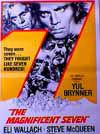 The
decade opened with one of the most popular, shoot-em-up westerns of all-time,
producer/director John Sturges' The Magnificent Seven (1960), lifting
the structure of another Akira Kurosawa film - the epic The Seven Samurai
(1954), about the defense of a small village. It was noted for Elmer
Bernstein's memorable, Oscar-nominated score. The film made stars of many
of its actors, notably Steve McQueen (and the other six: Brad Dexter,
Horst Buchholz, James Coburn, Robert Vaughn, Charles Bronson, and Yul
Brynner). John Wayne produced, directed, and starred as Col. Davy Crockett
in The Alamo (1960), a cliched, mushy, and overlong saga of patriots
defending the famous fort against the Mexican Army in the struggle for
Texas' independence. [The campaign to promote the film as a Best Picture
nominee and Chill Wills for a Best Supporting Actor nomination was successful,
foreshadowing further strong-armed tactics within the industry.] The
decade opened with one of the most popular, shoot-em-up westerns of all-time,
producer/director John Sturges' The Magnificent Seven (1960), lifting
the structure of another Akira Kurosawa film - the epic The Seven Samurai
(1954), about the defense of a small village. It was noted for Elmer
Bernstein's memorable, Oscar-nominated score. The film made stars of many
of its actors, notably Steve McQueen (and the other six: Brad Dexter,
Horst Buchholz, James Coburn, Robert Vaughn, Charles Bronson, and Yul
Brynner). John Wayne produced, directed, and starred as Col. Davy Crockett
in The Alamo (1960), a cliched, mushy, and overlong saga of patriots
defending the famous fort against the Mexican Army in the struggle for
Texas' independence. [The campaign to promote the film as a Best Picture
nominee and Chill Wills for a Best Supporting Actor nomination was successful,
foreshadowing further strong-armed tactics within the industry.]
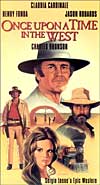 The
50's three-screen Cinerama process presented an all-star cast (James Stewart,
John Wayne, and Gregory Peck, for instance) in an overlong, epic Western
How the West Was Won (1963) that followed several generations of
the same family. It was directed by three greats: Henry Hathaway, John
Ford, and George Marshall. The
50's three-screen Cinerama process presented an all-star cast (James Stewart,
John Wayne, and Gregory Peck, for instance) in an overlong, epic Western
How the West Was Won (1963) that followed several generations of
the same family. It was directed by three greats: Henry Hathaway, John
Ford, and George Marshall.
Italian director Sergio Leone's beautifully-choreographed
and soundtracked, revisionist epic western Once Upon a Time in
the West (1968, It.), with
composer Ennio Morricone's score, mixed both violence and humor in arguably
one of the greatest westerns ever made. It was a story of conflict
between a land-owning ex-prostitute/widow (Claudia Cardinale) and
a railroad company, with Henry Fonda in an atypical against-type role
as Frank - a black-hearted, butchering villain, Charles Bronson as
the mysterious and brooding Harmonica, and Jason Robards as the untameable
escaped con scoundrel Cheyenne. The film's tagline proclaimed: "There
were three men in her life. One to take her... one to love her...
and one to kill her."
George Roy Hill's popular western Butch
Cassidy and the Sundance Kid (1969), about two perfectly-matched
outlaw-hero buddies (the dashing duo of Paul Newman as the head of the
Hole-in-the-Wall gang and Robert Redford as the gun-slinging kid), perfectly
reflected the mood and emotions of the time. It had both comedy ("Who
are those guys?") and graphic violence in its story of unflappable
western partners-in-crime who were romantically doomed to die together
in Bolivia. [The success of this likeable film brought the two 'dream
team' co-stars together with the same director four years later in the
Best Picture/Best Director winner The Sting (1973), and set the
archetype for many more buddy-hero films to come.]
60s Musicals:
Though musicals had declined by the 1960s and would decline further
in the next decade, three musicals in the decade were among the screen's
greatest spectacles:
- Robert Wise's and Jerome Robbins' boldly innovative,
exuberant and fresh West Side Story (1961)
- featured a Leonard Bernstein-Stephen Sondheim score - it was a modern,
New York re-telling of the tragic Romeo and Juliet star-crossed
love story, with dynamite choreography, and a sensitive depiction of
the problems of rival street gangs (Sharks vs. Jets) and juvenile delinquency;
with memorable roles played by Natalie Wood (as Maria) and Rita Moreno
(as Anita)
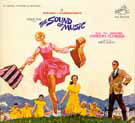 Lerner and Loewe's and director George Cukor's My
Fair Lady (1964), based on George Bernard Shaw's play Pygmalion -
with Rex Harrison recreating his Broadway role as wagering phonetics
Professor Henry Higgins, with the impossible mission of teaching
common Cockney flower-seller Eliza Doolittle how to be a lady
(Audrey Hepburn, who replaced snubbed Broadway star Julie Andrews,
had her singing dubbed by Marni Nixon, and was not nominated
for a Best Actress award) Lerner and Loewe's and director George Cukor's My
Fair Lady (1964), based on George Bernard Shaw's play Pygmalion -
with Rex Harrison recreating his Broadway role as wagering phonetics
Professor Henry Higgins, with the impossible mission of teaching
common Cockney flower-seller Eliza Doolittle how to be a lady
(Audrey Hepburn, who replaced snubbed Broadway star Julie Andrews,
had her singing dubbed by Marni Nixon, and was not nominated
for a Best Actress award) - Rodgers
and Hammerstein's and Robert Wise's The Sound
of Music (1965) reinvigorated the musical. It starred Julie
Andrews in her second film as Maria, a spunky governess for the von
Trapp family in Austria where "the hills were alive". The
film was the Best Picture and Director Academy Award winner - and it
surpassed Gone With the Wind (1939) as
the greatest box-office success. [In 1961 and 1968, the Civil War drama
was reissued and restored, outgrossing hundreds of new films in box
office receipts. Some objected to its wide-screen format in the re-releases.]
Stanley Donen, known for his musicals, also produced and directed Audrey
Hepburn and Albert Finney as a soul-searching married couple in the non-musical
romantic comedy Two For the Road (1967). Many other musicals of
the decade did extremely well:
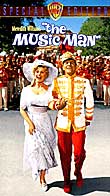 Can-Can
(1960) - a Cole Porter musical about a 19th century Parisian France Can-Can
(1960) - a Cole Porter musical about a 19th century Parisian France- Flower Drum Song (1961) - a Rodgers and Hammerstein
musical about a romance in San Francisco's Chinatown
- the screen adaptation of Meredith Wilson's book of
the Broadway stage hit - director Morton da Casta's thoroughly delightful,
lively and enjoyable The Music Man (1962) with Robert Preston
as the irrepressible, city-slicker con-art salesman Professor Harold
Hill who offers a boys' band to a small Iowa town
- Mervyn LeRoy's biopic musical Gypsy (1962),
originally a Broadway stage musical with Ethel Merman, starred Rosalind
Russell as stage Mom Rose, and Natalie Wood as stripteasing daughter
Gypsy Rose Lee
- the Broadway hit show of 1960, Bye Bye Birdie,
was adapted for the screen by Irving Brecher and directed by George
Sidney as Bye
Bye Birdie (1963). It was the first Broadway
musical to include rock songs; it told about an Elvis Presley-styled
pop star named Conrad Birdie (Jesse Pearson); Dick Van Dyke reprised
his role in the film as a struggling songwriter
who sang the upbeat "Put
on a Happy Face" to secretary-fiancee Rosie (Janet Leigh),
and 22 year-old Ann-Margret appeared in her third film (and sang
the title song during the opening credits before a blue-screen) as
16 year-old Kim McAfee - she was the lucky Ohio teenager who was
chosen to receive a farewell kiss from the rock idol (before he was
drafted into the military) on the TV variety program The
Ed Sullivan Show
- The Unsinkable Molly Brown (1964), adapted
from a Broadway hit - with Debbie Reynolds as a spunky, no-holds-barred
survivor of the SS Titanic and the wife of a gold-prospecting
husband
- Oliver! (1968) - a Best Picture and Best Director
winner (defeating Kubrick's sci-fi masterpiece 2001:
A Space Odyssey (1968)!), with Ron Moody as Fagin, and Mark
Lester as the hungry title character who asked for "More"
However, audiences stayed away from other post-The
Sound of Music musicals that were both expensive and old-fashioned,
some among the biggest
flops of all-time, with some of the decades' greatest stars:
- Doctor Doolittle (1967) with Rex Harrison
as an animal doctor who could 'talk to the animals'
- Joshua Logan's big-budget flop Camelot (1967) ,
film-adapted from Lerner and Loewe's Broadway hit musical, starred
Richard Harris (replacing Richard Burton) as King Arthur, Vanessa
Redgrave (replacing Julie Andrews) as Guenevere, Franco Nero (replacing
Robert Goulet) as Lancelot, and David Hemmings as Mordred
- George Sidney's old-fashioned, overblown, and formulaic
Half a Sixpence (1967, UK) with Tommy Steele; Sidney had earlier
directed these more successful Hollywood musicals: Anchors Aweigh
(1945), Annie Get Your Gun (1950), Kiss Me Kate (1953),
Pal Joey (1957), and Bye Bye Birdie (1963)
- Star! (1968) with Julie Andrews
- Hello, Dolly! (1969), with Barbra Streisand (see below)
- the California Gold Rush-era Paint Your Wagon (1969)
with unusually-cast western star Clint Eastwood (singing "I
Talk to the Trees") and Lee Marvin (singing "Wand'rin' Star")
- Blake Edwards' Darling Lili (1970), a old-style
musical that nearly bankrupted Paramount Pictures; it was the first
of seven films Blake and partner Julie Andrews made together; it
starred Andrews as the title character, a Mata-Hari like
German espionage agent during WWI, who romanced American pilot Maj.
William Larrabee (Rock Hudson)
Barbra Streisand:
 Powerhouse
singer Barbra Streisand's screen debut was in Funny Girl (1968),
a reprise of her Broadway role as comedienne Fanny Brice - director William
Wyler's film launched her into stardom. She tied for Best Actress (an
unprecedented feat) with Katharine Hepburn for The Lion in Winter (1968).
The next year, she was miscast as a matchmaking widow (who met her match
with eligible 'half-millionaire' Walter Matthau) in the lavish adaptation
of the popular Broadway show Hello, Dolly! (1969) directed by Gene
Kelly - with Louis Armstrong presenting his rendition of the title song.
At the start of the 70s, Streisand appeared in two other pictures: Vincente
Minnelli's musical On A Clear Day You Can See Forever (1970) and
Herbert Ross' romantic comedy The Owl and the Pussycat (1970) opposite
George Segal. Powerhouse
singer Barbra Streisand's screen debut was in Funny Girl (1968),
a reprise of her Broadway role as comedienne Fanny Brice - director William
Wyler's film launched her into stardom. She tied for Best Actress (an
unprecedented feat) with Katharine Hepburn for The Lion in Winter (1968).
The next year, she was miscast as a matchmaking widow (who met her match
with eligible 'half-millionaire' Walter Matthau) in the lavish adaptation
of the popular Broadway show Hello, Dolly! (1969) directed by Gene
Kelly - with Louis Armstrong presenting his rendition of the title song.
At the start of the 70s, Streisand appeared in two other pictures: Vincente
Minnelli's musical On A Clear Day You Can See Forever (1970) and
Herbert Ross' romantic comedy The Owl and the Pussycat (1970) opposite
George Segal.
Films from Disney Studios in the 60s:
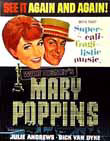 Walt
Disney Studios re-emerged as a triumphant box-office moneymaker and producer
of a variety of expensive-to-produce, animated and likable, wholesome
live-action family features during the decade, including the following: Walt
Disney Studios re-emerged as a triumphant box-office moneymaker and producer
of a variety of expensive-to-produce, animated and likable, wholesome
live-action family features during the decade, including the following:
- Pollyanna (1960), a family drama, brought
child star Hayley Mills (with her first of six films for Disney)
a special juvenile Oscar for the role as an optimistic orphan
- The Swiss Family Robinson (1960), an adaptation
of Johan Wyss' tale about a shipwrecked family (headed by Dorothy
McGuire and John Mills) on a desert island; one of the top-grossing
films of 1960
- the delightfully animated 101 Dalmatians (1961),
the highest grossing film of the year at $186.6 million, featured
adorable puppies and villainesse Cruella DeVille
- The Absent-Minded Professor (1961), a comedy
with Fred MacMurray as a wacky scientist who invents flubber (flying
rubber) and is pursued by Cold War spies who want the formula. It
was the fifth top-grossing film of the year. The popular sequel to The
Absent-Minded Professor was Son
of Flubber (1963)
- The Parent Trap (1961) with fresh-faced adolescent
Hayley Mills playing twins through clever trick photography; it was the
sixth top-grossing film of the year
- Bon Voyage! (1962), another lightweight comedy
about a family's vacation to Paris, with Fred MacMurray and Jane Wyman
as the parents of three children (Tommy Kirk, Deborah Walley, and Kevin
Corcoran)
- The Sword in the Stone (1963), an animated
story based on the 1938 novel by T.H. White, about a medieval sword
blade embedded in a rock
- Mary Poppins (1964), a delightful musical fantasy
combining animation and live-action sequences, and featuring Best Actress-winning
Julie Andrews in her screen debut as an energetic, eccentric nanny with
magical powers in Edwardian London; also with Dick Van Dyke, and the
song "Supercalifragilisticexpialidocious"
- The Jungle Book (1967), the last, full-length
animated film that the legendary Walt Disney supervised before his death
in 1966
- The Love Bug (1968), one of the top-grossing
films of the year, about an anthropomorphic Volkswagen 'beetle' named
Herbie with driver Dean Jones
 Film History of the 1960s
Film History of the 1960s
Part 1, Part 2, Part 3, Part 4, Part 5, Part 6

 
|
